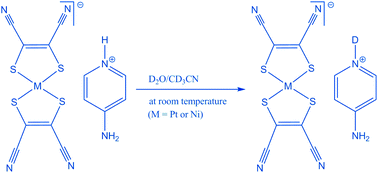The ion-pair complexes of [4-NH2-PyH][M(mnt)2] (M = Pt for 1 and Ni for 3) and their deuterated analogues [4-NH2-PyD][M(mnt)2] (M = Pt for 2 and Ni for 4) are isostructural with each other. Four complexes crystalline in monoclinic space group C2/c, whose asymmetric unit consists of two halves of [M(mnt)2]− anions and one cation, show quite similar cell parameters and almost identical packing structures as well. In the crystals of 1–4, two types of crystallographically inequivalent [M(mnt)2]− anions construct individual layers, which are separated by the cation layer; the supramolecular networks are formed via the H-bonding interactions between the [M(mnt)2]− and 4-NH2-PyH+ (or 4-NH2-PyD+) ions as well as the weakly π⋯π stacking interactions between the [M(mnt)2]− anions. The four isostructural complexes exhibit canted antiferromagnetism, arising from the non-collinearity of the magnetic moments between the crystallographically inequivalent anion layers, with TC ≈ 14.8 K for 1, 13.6 K for 2, 7.7 K for 3 and 8.8 K for 4, respectively. Ac magnetic susceptibility measurements revealed that 1 and 2 show spin canting, while 3 and 4 show hidden-spin canting characteristics. The isostructural 1 and 3 were deuterated to give the divergent isotope effects on the cell volume and TC.

You have access to this article
 Please wait while we load your content...
Something went wrong. Try again?
Please wait while we load your content...
Something went wrong. Try again?


 Please wait while we load your content...
Please wait while we load your content...